Menus
- Motocrossers from Honda, Kawasaki, KTM, Suzuki and Yamaha
- Yamaha YZ 450 F.
- Honda CRF 450 R.
- KTM 450 SX-F
- Suzuki RM-Z 450
- KTM 350 SX-F
- Kawasaki KX 450 F
- MOTORCYCLE off-road rating
- MOTORCYCLE test results / performance
- Technical specifications
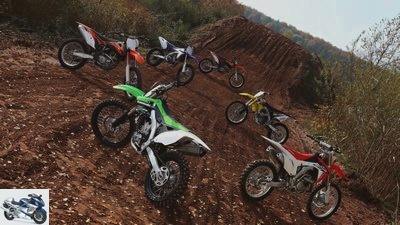
Jahn
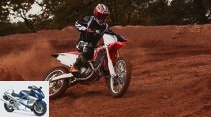
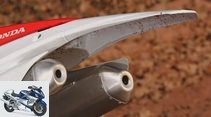


16 photos
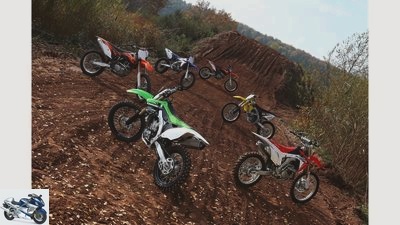
Jahn
1/16
Kawasaki KX 450 F, KTM 350 SX-F, Yamaha YZ 450 F, KTM 450 SX-F, Suzuki RM-Z 450 and Honda CRF 450 R in the large MX1 (450cm³) comparison test.
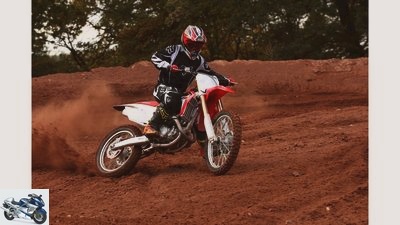
Jahn
2/16
Honda CRF 450 R – Precise: Razor-sharp handling is still the strength of the Honda. However, moderate revving and little punch reduce driving pleasure.
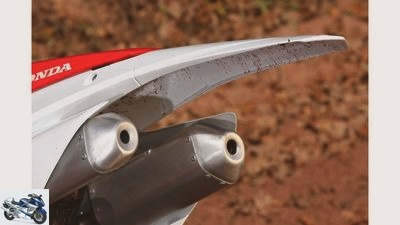
Jahn
3/16
Honda CRF 450 R – a matter of reason: The – basically laudable – double silencer slows the Honda enormously.
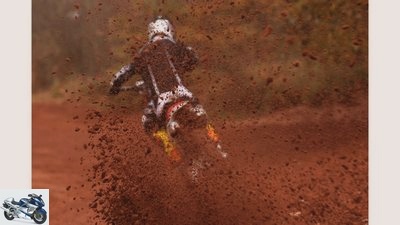
Jahn
4/16
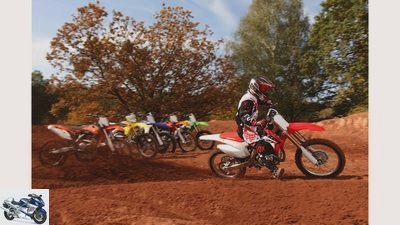
Jahn
5/16
Gone? Are you kidding me? Are you serious when you say that! The MX1 Crossers had a close race.
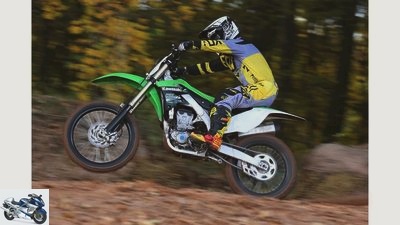
Jahn
6/16
Kawasaki KX 450 F – Finally ahead: With a well-coordinated overall package, the KX wins the comparison test. Inspiring: the fine engine.
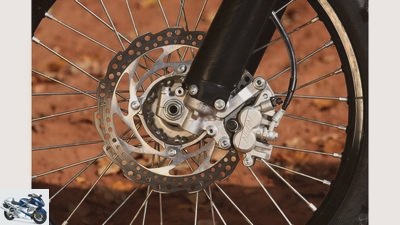
Jahn
7/16
Kawasaki KX 450 F – not braked: A modified master cylinder and new brake pads upgrade the Kawa brake.
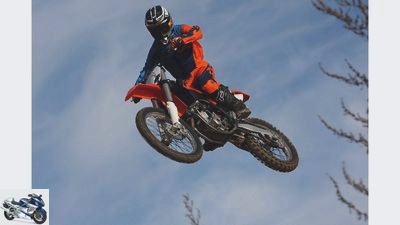
Jahn
8/16
KTM 350 SX-F: The best of both worlds? Most of the advertising copy exaggerates – the one on the 350 KTM doesn’t. The universal motor is just as suitable for hobby crossers as it is for experts. Chapeau!

Jahn
9/16
KTM 350 SX-F – The resonance chamber should bring more pressure from below and less noise – it obviously works both.
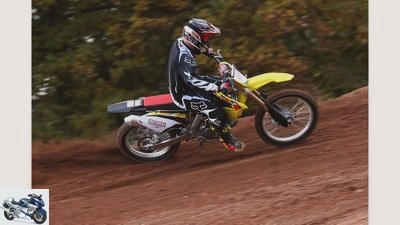
Jahn
10/16
Suzuki RM-Z 450: Small causes, big effect: With fine retouching, Suzuki uncovered the potential of the MX1-Crosser – finally!
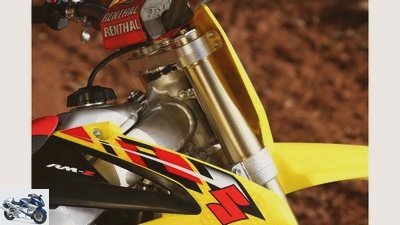
Jahn
11/16
Suzuki RM-Z 450 The SFF fork (spring in the right, damping in the left bar) offers plenty of reserves.
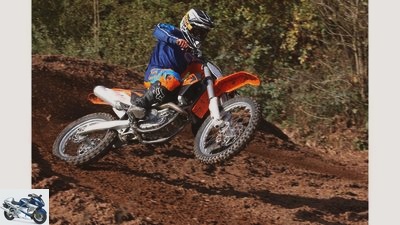
Jahn
12/16
KTM 450 SX-F: A picture is worth a thousand words: The 450 KTM is primarily defined by one thing – pressure from every corner.
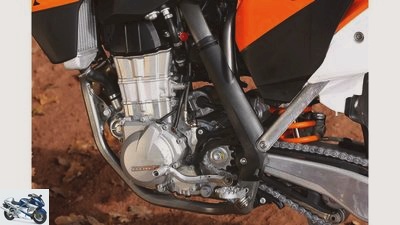
Jahn
13/16
KTM 450 SF-X First appearance, first US title – there is temperament for professional crossers in the new KTM 450 engine.
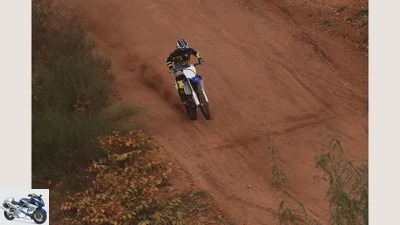
Jahn
14/16
Yes, I can: Only the aggressive engine tuning slows down the YZ. The technical concept has potential for more.
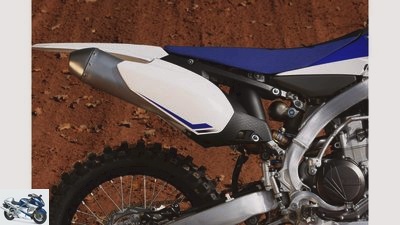
Jahn
15/16
Yamaha YZ 450 F Unconventional: The airbox behind the steering head gives the YZ an airy rear.
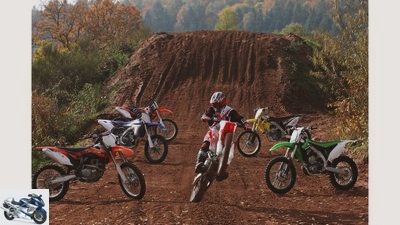
Jahn
16/16
This time the Honda CRF 450 R only lands in fifth place. The Kawasaki KX 450 F wins the group test ahead of the KTM 350 SX-F.
Motocross comparison test MX1 (450 cm³)
Motocrossers from Honda, Kawasaki, KTM, Suzuki and Yamaha
For three years now, the jet from the Honda CRF 450 R, serial winner of the MOTORRAD-Motocross comparison, has been pounding on the MX1 gang. Enough to win number four with the 2013 model?
Yamaha YZ 450 F.
Let’s not talk around it. The following still applies to the MX1 category: It is the MotoGP class of motocross sport. Whoever is up here is in the spotlight. And what applies to the riders also counts for the bikes. It is important to find the balance between performance and controllability, between handling and stability. Who can achieve the perfect compromise? Six identical tires (Dunlop Geomax MX-51) MX1 cars, two tracks and MOTORCYCLE off-road specialist Didi Lacher are ready.
Yamaha YZ 450 F.
F.For the 2010 season, the Yamaha technicians leaned mightily out of the window and tried to revolutionize the off-road world with a new concept. With the cylinder tilted backwards, the cylinder head turned upside down, the air filter behind the steering head and the exhaust pipe that is led directly to the rear, the mass-centralized YZ 450 F should dupe the competition in terms of handling. However, the theoretical advantage of the avant-garde off-roader was thwarted by the engine, whose extraordinarily biting response behavior overwhelmed even experienced pilots. The response remained cautious. The modifications (revised mapping, new suspension tuning) as well.
Buy complete article

Motocross comparison test MX1 (450 cm³)
Motocrossers from Honda, Kawasaki, KTM, Suzuki and Yamaha
Yamaha leaves its mark. The intake snorkeling takes just as much getting used to as the said overly sensitive throttle response of the single. It is not only on low-traction terrain that you need practiced fine motor skills to accelerate the Yamaha – and a lot of stamina to master it from mid-rev. The single, which has been strengthened by four to 58 hp – probably due to the changed mapping – thunders rapidly and with power through the rev range. Which is why the YZ has to let itself depend on the more finely honed competition in this regard, especially in a core criterion of the 450 class, drivability. A faux pas that made them lose touch in the tight test field. Sixth place.
Honda CRF 450 R.
Jahn
Honda CRF 450 R – Precise: Razor-sharp handling is still the strength of the Honda. However, moderate revving and little punch reduce driving pleasure.
Driveability is the argument with which Honda won the last three MX1 group tests by MOTORRAD. Agile handling and easily manageable power remain the dominant themes of the CRF 450 R, which has been extensively revised for the 2013 season. But first on the positive side. The CRF continues to stage great cinema in terms of handling. Reinforced by the reduced ride height, it catches exactly the tight line, flicks through the difficult neighboring area, folds down effortlessly, feels more balanced in the air than any other crosser and remains the nimble star as always. The new PSF fork (Pneumatic Spring Fork) is also doing well. Equipped with an air chamber instead of springs, the brand new Showa part saves around 750 grams in weight and can be easily adjusted with an air pump for mountain bike suspension forks (air pressure in the test: 2.4 bar). The response behavior is on the level of conventional forks, the punch reserves are greater. Of course, no statement can be made about the tightness of the system over the course of a season or even after years of use. For the shock absorber, hobby pilots should also increase the spring preload (sag with driver: 95 millimeters) in order to raise the rear end that tends to sag.
And the engine? The intention of the Honda product planners to reduce the level of noise in off-road sports is generally commendable. For years, the Honda crossers have been banging their sound far below the permissible noise level on the cross slopes. That’s a good thing. Especially since the calming treatment in the exhaust tract was ultimately also responsible for the gentle, easily controllable performance characteristics of the -Unicam singles. And just as the double silencer used for the first time in the CRF 450 R succeeded in reducing the riot again, the calming treatment seems to have constricted the propellant. The red pulls out of the neighboring areas, tame through the middle of the rev range and is the first in the 450 class to seal off. Early – and therefore, unfortunately, frequent – switching is the only chance to keep the CRF on the train. Despite everything, this characteristic may even be efficient and gentle on condition, but it generates little driving pleasure. Even hobby crossers will not be able to avoid a -free retrofit silencer – despite all common sense and responsibility.
What a shame. Because – apart from the problematic deterioration of the clutch while driving – the CRF unit shines with outstanding smoothness and wonderfully low-friction mechanics. But after three years of reign, the engine that was choked on the exhaust pushes the CRF 450 R from the throne to fifth place. And shows that – as in real life, voluntary self-restraint rarely works. Even rarer in racing.
KTM 450 SX-F
Jahn
KTM 450 SX-F: A picture is worth a thousand words: The 450 KTM is primarily defined by one thing – pressure from all corners.
With the title in the American Motocross Championship from works driver Ryan Dungey, the debut of the KTM 450 -SX-F could not have been more spectacular. All the more so as the successful crosser is actually powered by the engine of the competition enduro 450 EXC-F and the modifications of the compact single with ohc valve train (titanium valves, sharper control times, higher compression) for more stringent motocross use are kept within surprisingly manageable limits . Little of which can be felt on the route. The propellant – like all KTM crossers, laudably equipped with an electric starter – gets down to business as if it had never been designed for any other purpose than catapulting the SX-F over 30-meter tables or heaving it out of the berms with rolled up sleeves. The fact that the longest stroke of all 450 engines also has the greatest speed reserves and revs up to 11,400 rpm ultimately wipes away even the last memories of its enduro origins. This single is a professional engine. Amateurs can quickly overwhelm the huge punch, at least on hard or greasy slopes. Perhaps that is why the technicians have given the European model of the SX-F a wider, four-speed gearbox instead of the narrower stepped five-speed gearbox of the US model.
So be it. Finally, the chassis is less pointedly aligned. Compared to the competition, the slimmest of all tank-seat combinations, the new plastic parts and the now higher, position-adjustable handlebars cover the entire range of pilots. In terms of handling and steering precision, the new 450 is just as brilliant as it is with the best-in-class brakes. While the fork impresses with its responsiveness and sufficient reserves, only the tuning of the shock absorber is surprising. Little dampened in the rebound stage and also has a very narrow adjustment range, the WP damper does not fit the profit-oriented alignment of the 450 SX-F at all. Even with the rebound stage damping completely turned down, the rear kicks on hard stretches with braking waves or jumps. Conversion by a specialist is essential for sand slopes. A faux pas, which together with the demanding engine of the new 450 series, at least for normal crossers, blocked the way to the top. Fourth place.
Suzuki RM-Z 450
Jahn
Suzuki RM-Z 450: Small causes, big effect: With fine retouching, Suzuki uncovered the potential of the MX1-Crosser – finally!
How much the field has come closer together, Suzuki had to learn bitterly in the past comparative tests. Often it was only nuances that separated the yellow from the test field – and still relegated it to the lower ranks. The guys in yellow now put their MX1 crosser to the core with fine work. And as strange as it may sound in the environment of some totally revised bikes (Honda, Kawasaki, KTM 450) – it is precisely the model maintenance policy of small steps that brings Suzi back on the road to success.
Above all, the engine, which has been running rather rough up to now, has been refined after the minor interventions (lighter piston, changed valve timing, revised mapping). As usual, the RM-Z unit with its strong character balances itself out of the lower rev range in a manageable manner, pushes vigorously through the middle of the rev range and – if a gear change is not worthwhile on short straights – can even be overturned. But while the coarse vibrations have so far intuitively made the Suzi pilot an early switch, the revised single now flatters with significantly lower vibrations and allows the trainer to use a much wider range of the speed repertoire almost unconsciously. In addition, the RM-Z now rolls more nimbly towards the hairpin bends with significantly reduced engine braking and feels more neutral in the air than ever before. Because the very precise and easy-to-shift gearbox also defines the new class standard, Suzi – small causes, big effects – moves far ahead with this engine.
But while the propulsion unit inspires the spectrum from the hobby to the professional crosser, the chassis is dedicated to the elite. Both the fork and the shock absorber are clearly tuned on the tight side, only work properly at a brisk pace and therefore require the pilot to be ambitious on the throttle. Anyone who is able to do so will benefit from the confidence-inspiring driving experience and the huge reserves of the Showa Separate Function Fork (spring in the right bar, damping in the left bar) and the shock absorber, which is also from Showa. Anyone who hesitates instead hops uncomfortably over braking waves and acceleration edges and realizes that despite the second place in the yellow in the comparison test, a strong commitment from the driver is still required for fast laps.
KTM 350 SX-F
Jahn
KTM 350 SX-F: The best of both worlds? Most of the advertising copy exaggerates – the one on the 350 KTM doesn’t. The universal motor is just as suitable for hobby crossers as it is for experts. Chapeau!
With the 350 SX-F, the Austrians are getting closer from year to year to the full-bodied promise of combining the handling of a 250 with the power of a 450. At least in terms of performance, the connection was made in model year 2013: the revised engine (new housing, larger inlet cross-section, higher maximum speed) presses 55 hp on the test stand roller. Seven HP more than the previous model (MOTORRAD 24/2011). Impressive.
But especially in the MX1 profession, performance is far from everything, sometimes even counterproductive. In this respect, the strong appearance of this 350 unit needs a differentiated assessment. Because instead of demanding high-speed orgies (maximum speed 13,300 / min!) Due to its displacement disadvantage, the 350 pushes unexpectedly powerfully even from low speeds, purrs through the middle of the speed, can be shifted up quickly and behaves as user-friendly as an enduro engine. Amateurs will love the 350 concept for it – and who have never exhausted the potential of this engine. Because if you want to be fast, you need them, those speed orgies. Letting go instead of shifting up, adopting the aggressive 250cc driving style, this pulls the good mask off the face of the short-stroke. And is rewarded for it. The lap times can be filed down in seconds, making the lively and fitness-friendly 350 SX-F as fast or even faster in the long run than most 450s. A universality with which – the engine, however, which runs quite rough – clearly stands out from the MX1 field.
Because this propellant is in the almost identical chassis of the 450 SX-F, the MX1-Hybrid-Crosser also copies its characteristics: successful handling, great ergonomics and an appealing fork – but also the shock absorber, which is underdamped in the rebound stage and can only be adjusted to a limited extent. And screwed up the 350 with a possible sensation, the overall victory in the 450 group test.
Kawasaki KX 450 F
Jahn
Kawasaki KX 450 F – Finally ahead: With a well-coordinated overall package, the KX wins the comparison test. Inspiring: the fine engine.
Winner of hearts. If any MX1 crosser deserves this title, it is the Kawasaki. The Kawa has often just barely missed the winner’s podium in MOTORRAD comparison tests in recent years.
And now, with the 2013 model? First of all, the technicians tamed the most powerful of all MX1 engines with 59 hp. Due to changed timing, the KX propellant has three horsepower less than last year – and benefits from it in every respect. While the dohc motor has already shone with great smoothness and minimal drag torque, the new motor setup now hits the perfect mix between the power expected from a 450cc bike and its necessary controllability. The Kawa pushes out of the corners in a clean and first-class manner, turns lively but not too aggressively and makes it child’s play for the pilot to pass on the still potent performance stress-free on bumpy terrain. It couldn’t be much better. So good that the cocky Kawa driver is trying to lure the KX propellant even more from the reserve with the changed mapping variants that can be activated via a plug. However: only experts will know how to use the livelier power delivery (white plug) on high-traction floors. While the black plug unnecessarily tames the successful response and makes no sense either for hobby crossers or professionals.
Especially since the Kawa trainer is not only given the experience of impressive traction through the engine setup. Supported by the excellently tuned shock absorber, the rear wheel sticks as if it were sucked into place even over hard acceleration edges and always stays on the ground, even in the worst braking waves. The downside of the coin: In smooth curves, the front pushes outwards despite the fork tubes being pushed through far (two rings visible). Speaking of fork. The front of the Kawa benefits from the PSF fork more than that of the Honda, which is also equipped with this air fork. The Kayaba part responds properly, can be easily adjusted for every driving level and gives the KX, which is subjectively a bit heavier than the Honda, a bit more lightness thanks to the weight advantage of 750 grams.
And because the KX ultimately admits to its peculiarities (deep rear, sweeping dimensions), serves the entire range of driving with its chassis, is in no way a real nakedness and garnishes the ensemble with an almost perfect engine, the finely honed KX 450 lands F finally where she wanted to be for a long time – right at the top of the podium.
MOTORCYCLE off-road rating
Jahn
This time the Honda CRF 450 R only lands in fifth place. The Kawasaki KX 450 F wins the group test ahead of the KTM 350 SX-F.
| Max points | Honda | Kawasaki | KTM 350 SX-F | KTM 450 SX-F | Suzuki | Yamaha | Overall rating | 250 | 215 | 219 | 218 | 216 | 218 | 212 | placement | 5. | 1. | 2. | 4th. | 2. | 6th. |
In the MX2 class, the requirements are clear: what counts is top performance. After all, the potential of the 250cc bikes with between 38 and 45 hp can also be exploited by many hobby riders. Things are different in the MX1 category. The aim here is to bring the enormous thrust of the powerful 450s singles (54 to 58 hp) into harmony with the traction that is currently limited on hard-skid or slippery slopes. The reason why amateurs usually find it easier with less aggressive, often even less powerful machines (Honda, KTM 350 SX-F). Experts are better able to use the advantages of powerful engines (KTM 450 SX-F) or stiffer, tuned chassis with large reserves (Suzuki RM-Z 450). Which for whom? Here is the specified MOTORCYCLE rating:
| amateur | expert | 1. | KTM 350 | Suzuki |
| 2. | Kawasaki | KTM 450 | 3. | Honda | Kawasaki |
| 4th. | Suzuki | KTM 350 | 5. | KTM 450 | Yamaha |
| 6th. | Yamaha | Honda |
MOTORCYCLE test results / performance
Jahn
Gone? Are you kidding me? Are you serious when you say that! The MX1 Crossers had a close race.
1.Kawasaki KX 450 F
The Kawa succeeded in the coup. Because it retains its traditional strengths with good traction and successful suspension tuning and garnishes the whole thing with a fantastically controllable and powerful engine.
2. KTM 350 SX-F
The 350 achieves the perfect compromise. The engine pushes from below, turns horrendously, delivers 55 hp 450cc power and sits in a first-class chassis. Only the shock absorber needs aftercare.
3. Suzuki RM-Z 450
The fine tuning of the RM-Z pays off in the narrow field of MX1 crossers. The handling remained excellent, the engine improved in smoothness. However: The suspension is clearly focused on experts.
4. KTM 450 SX-F
With the new 450, KTM is putting a professional crosser on wheels. The single goes like hell, the chassis operates at a top level. Only the shock absorber requires rework – even more than with the 350.
5. Honda CRF 450 R
Excellent steering precision, great handling and good suspension – this is how the CRF preserves all its advantages. But the extremely constricted engine slows down the overall package lastingly.
6.Yamaha YZ 450 F
Handling and suspension are on a good level, but the nervous response of the unconventional engine tears at the nerves and strength of the pilot. The courage to try something new is still not rewarded.
Technical specifications
| Honda | Kawasaki | KTM 350 | engine |
| design type | water-cooled single cylinder- Four-stroke engine with four valves |
water-cooled single cylinder- Four-stroke engine with four valves |
water-cooled single cylinder- Four-stroke engine with four valves |
Valve train | ohc | dohc | dohc |
| Displacement | 449 cc | 449 cc | 350 cc | Bore x stroke | 96 x 62.1 mm | 96 x 62.1 mm | 88 x 57.5 |
| compression | 12.5 | 12.5 | 13.6 | Power* | 39.7 kW (54 PS) at 9,100 rpm | 41.1 kW (56 hp) at 9000 rpm | 40.3 kW (55 hp) at 11,200 rpm |
| Mixture preparation | injection | injection | injection | diameter | 46 mm | 43 mm | 44 mm |
| Corridors | 5 | 5 | 5 | landing gear |
| frame | Bridge frame made of aluminum | Bridge frame made of aluminum | Single-loop frame made of tubular steel | Fork / strut | Kayaba | Kayaba | WP suspension |
| Guide tube diameter | 48 mm | 48 mm | 48 mm | Suspension travel v / h | 310/315 mm | 314/315 mm | 300/330 mm |
| Weight (without petrol) * | 107 kg | 108 kg | 107 kg | Price without additional costs | 8115 euros | 8295 euros | 8595 euros |
| KTM 450 | Suzuki | Yamaha | engine |
| design type | water-cooled single cylinder- Four-stroke engine with four valves |
water-cooled single cylinder- Four-stroke engine with four valves |
water-cooled single cylinder- Four-stroke engine with four valves |
Valve train | ohc | dohc | dohc |
| Displacement | 449 cc | 449 cc | 449 cc | Bore x stroke | 95 x 63.4 mm | 96 x 62.1 mm | 97 x 60.8 mm |
| compression | 12.6 | 12.5 | 12.5 | Power* | 41.9 kW (57 hp) at 9500 rpm | 41.2 kW (56 hp) at 8600 rpm | 43.0 kW (58 hp) at 9200 rpm |
| Mixture preparation | injection | injection | injection | diameter | 44 mm | 43 mm | 44 mm |
| Corridors | 4th | 5 | 5 | landing gear |
| frame | Single-loop frame made of tubular steel | Bridge frame made of aluminum | Bridge frame made of aluminum | Fork / strut | WP suspension | Showa | Kayaba |
| Guide tube diameter | 48 mm | 48 mm | 48 mm | Suspension travel v / h | 300/330 mm | 310/310 mm | 310/310 mm |
| Weight (without petrol) * | 109 kg | 110 kg | 108 kg | Price without additional costs | 8895 euros | 8180 euros | 8495 euros |
* MOTORCYCLE readings
Related articles
-
MX1 crossers from Honda, Kawasaki, KTM, Suzuki and Yamaha put to the test
Jahn 16 pictures Jahn 1/16 In the test: Honda CRF 450 R, Yamaha YZ 450 F, Suzuki RM-Z 450, KTM 350 SX-F, Kawasaki KX 450 F and KTM 450 SX-F. Jahn 2/16 KTM 350 …
-
fact Concept comparison Honda CBR 1100 XX Kawasaki ZX-12 R Suzuki GSX-R 1000 Suzuki GSX 1400 Yamaha FZS 1000 Fazer Yamaha FJR 1300 Six bombs The six most…
-
Jahn 35 photos Jahn 1/35 Husqvarna TC 250 R in the motocross comparison test. Jahn 2/35 Yamaha YZ 250 F in the motocross comparison test. Jahn 3/35…
-
Honda, Kawasaki, KTM, Suzuki and Yamaha Crosser in the test
Honda Comparison test: Motocross MX2 (up to 250 cm³) Crossers from Honda, Kawasaki, KTM, Suzuki and Yamaha in the test The Suzuki RM-Z 250 has dominated…
-
Honda CBR 650 F, Suzuki GSX 650 F, Yamaha XJ6 Diversion F in the test
fact 46 photos fact 1/46 The Suzuki as a solid all-rounder, the Yamaha as a lively fun bike. Honda is changing the CB 650 F with the casing, on the other…
-
Comparison test Suzuki SV 650, Honda CB 650 F, Kawasaki ER-6n, Yamaha MT-07
www.bilski-fotografie.de 34 photos www.bilski-fotografie.de 1/34 They are the hottest contenders among the mid-range naked bikes….
-
Yamaha MT-07, Kawasaki ER-6, Suzuki Gladius 650 and Ducati Monster in the test
Jahn 39 pictures Jahn 1/39 Where I am is in front – the MT-07 is addicted to curves. Jahn 2/39 Less saved: At least the fork can be …
-
Jahn Comparison test of supersports: Ducati 998, Honda Fireblade, Kawasaki ZX-9R, Suzuki GSX-R 1000, Triumph Daytona 955i Centennial The K question Five…
-
Comparison test touring enduro bikes: Honda Transalp, Kawasaki Versys, Suzuki V-Strom 650
Jahn Comparison test of travel enduro bikes: Honda Transalp, Kawasaki Versys, Suzuki V-Strom 650 Always along the wall Travel enduro doesn’t necessarily…
-
Honda CBF 600, Kawasaki ER-6n, Suzuki Gladius 650 and Yamaha XJ6
Artist Honda CBF 600, Kawasaki ER-6n, Suzuki Gladius 650 and Yamaha XJ6 Comparison test all-rounder Looking for a partner in the world of all-rounders?…